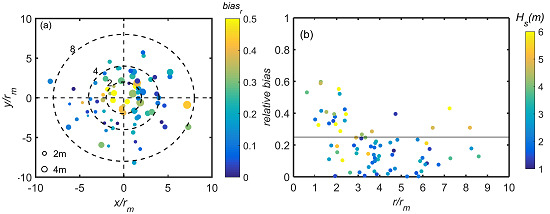Typhoon/Hurricane-Generated Wind Waves Inferred from SAR Imagery
Abstract
:1. Introduction
2. Data and Methods
2.1. Sentinel-1 SAR Wave Mode
2.2. RADARSAT-2 ScanSAR Mode
2.3. The Fetch- and Duration-Limited Wind Wave Models (H-Models)
3. Results
3.1. Validation of H-Models by Sentinel-1A SAR Wave Mode Wind and Wave Data
3.1.1. Typhoon Krovanh
3.1.2. 12 Pacific Typhoons
3.2. Wind Waves from RADARSAT-2 ScanSAR Mode Hurricane Winds
3.2.1. Validation by Wave Buoys
3.2.2. 2-Dimensional Application
4. Discussion
5. Conclusions
Author Contributions
Funding
Acknowledgments
Conflicts of Interest
References
- Craig, P.D.; Banner, M.L. Modeling wave-enhanced turbulence in the ocean surface layer. J. Phys. Oceanogr. 1994, 24, 2546–2559. [Google Scholar] [CrossRef]
- Craig, P.D. Velocity profiles and surface roughness under breaking waves. J. Geophys. Res. 1996, 101, 1265–1277. [Google Scholar] [CrossRef]
- Toffoli, A.; McConochie, J.; Ghantous, M.; Loffredo, L.; Babanin, A.V. The effect of wave-induced turbulence on the ocean mixed layer during tropical cyclones: Field observations on the Australian North-West Shelf. J. Geophys. Res. 2012, 117, 1–8. [Google Scholar] [CrossRef]
- Reichl, B.G.; Wang, D.; Hara, T.; Ginis, I.; Kukulka, T. Langmuir turbulence parameterization in tropical cyclone conditions. J. Phys. Oceanogr. 2016, 46, 863–886. [Google Scholar] [CrossRef]
- Perrie, W.; Toulany, B.; Roland, A.; Dutour-Sikiric, M.; Chen, C.; Beardsley, R.C.; Chen, C.; Beardsley, R.C.; Qi, J.; Hu, Y.; et al. Modeling North Atlantic Nor’easters with modern wave forecast models. J. Geophys. Res. 2018, 123, 533–557. [Google Scholar] [CrossRef]
- Cardone, V.J.; Jensen, R.E.; Resio, D.T.; Swail, V.R.; Cox, A.T. Evaluation of contemporary ocean wave models in rare extreme events: The Halloween Storm of October 1991 and the Stormof the Century of March 1993. J. Atmos. Ocean. Technol. 1996, 13, 198–230. [Google Scholar] [CrossRef]
- Beal, R.C.; Gerling, T.W.; Irvine, D.E.; Monaldo, F.M. Spatial variations of ocean wave directional spectra from the Seasat synthetic aperture radar. J. Geophys. Res. 1986, 91, 2433–2449. [Google Scholar] [CrossRef]
- Wright, C.W.; Walsh, E.J.; Vandemark, D.; Krabill, W.B.; Garcia, A.W.; Houston, S.H.; Powell, M.D.; Black, P.G.; Marks, F.D. Hurricane directional wave spectrum spatial variation in the open ocean. J. Phys. Oceanogr. 2001, 31, 2472–2488. [Google Scholar] [CrossRef]
- Walsh, E.J.; Wright, C.W.; Vandemark, D.; Krabill, W.B.; Garcia, A.W.; Houston, S.H.; Murillo, S.T.; Powell, M.D.; Black, P.G.; Marks, F.D., Jr. Hurricane directional wave spectrum spatial variation at landfall. J. Phys. Oceanogr. 2002, 32, 1667–1684. [Google Scholar] [CrossRef]
- Forristall, G.Z.; Ward, E.G.; Cardone, V.J.; Borgmann, L.E. The directional spectra and kinematics of surface gravity waves in tropical storm Delia. J. Phys. Oceanogr. 1978, 8, 888–909. [Google Scholar] [CrossRef]
- Collins, C.O.; Potter, H.; Lund, B.; Tamura, H.; Graber, H.C. Directional wave spectra observed during intense tropical cyclones. J. Geophys. Res. 2018, 123, 773–793. [Google Scholar] [CrossRef]
- Collins, C.O. Typhoon Generated Surface Gravity Waves Measured by NOMAD-Type Buoys. Ph.D. Thesis, University of Miami, Coral Gables, FL, USA, 2014. [Google Scholar]
- Xu, Y.; He, H.; Song, J.; Hou, Y.; Li, F. Observations and Modeling of Typhoon Waves in the South China Sea. J. Phys. Oceanogr. 2017, 47, 1307–1324. [Google Scholar] [CrossRef]
- Hasselmann, K.; Hasselmann, S. On the nonlinear mapping of an ocean wave spectrum into a synthetic aperture radar image spectrum and its inversion. J. Geophys. Res. 1991, 96, 10713–10729. [Google Scholar] [CrossRef]
- Mastenbroek, C.D.; Valk, C.D. A semiparametric algorithm to retrieve ocean wave spectra from synthetic aperture radar. J. Geophys. Res. 2000, 105, 3497–3516. [Google Scholar] [CrossRef] [Green Version]
- Sun, J.; Guan, C.L. Parameterized first-guess spectrum method for retrieving directional spectrum of swell-dominated waves and huge waves from SAR images. Chin. J. Oceanol. Limnol. 2006, 24, 12–20. [Google Scholar]
- Sun, J.; Kawamura, H. Retrieval of surface wave parameters from SAR images and their validation in the coastal seas around Japan. J. Oceanogr. 2009, 65, 567–577. [Google Scholar] [CrossRef]
- Shao, J.; Li, X.; Sun, J. Ocean wave parameters retrieval from TerraSAR-X images validated against buoy measurements and model results. Remote Sens. 2015, 7, 12815–12828. [Google Scholar] [CrossRef]
- Schulz-Stellenfleth, J.; Lehner, S.; Hoja, D. A parametric scheme for the retrieval of two-dimensional ocean wave spectra from synthetic aperture radar look cross spectra. J. Geophys. Res. 2005, 110, 297–314. [Google Scholar] [CrossRef]
- Hasselmann, K.; Raney, R.K.; Plant, W.J.; Alpers, W.; Shuchman, R.A.; Lyzenga, D.R.; Rufenach, C.L.; Tucker, M.J. Theory of synthetic aperture radar ocean imaging: A MARSEN view. J. Geophys. Res. 2005, 90, 4659–4686. [Google Scholar] [CrossRef]
- Schulz-Stellenfleth, J.; König, T.; Lehner, S. An empirical approach for the retrieval of integral ocean wave parameters from synthetic aperture radar data. J. Geophys. Res. 2007, 112, 1–14. [Google Scholar] [CrossRef]
- Li, X.; Lehner, S.; Bruns, T. Ocean wave integral parameter measurements using Envisat ASAR wave mode data. IEEE Trans. Geosci. Remote Sens. 2011, 49, 155–174. [Google Scholar] [CrossRef] [Green Version]
- Stopa, J.E.; Mouche, A. Significant wave heights from Sentinel-1 SAR: Validation and applications. J. Geophys. Res. 2017, 122, 1827–1848. [Google Scholar] [CrossRef]
- Romeiser, R.; Graber, H.C.; Caruso, M.J.; Jensen, R.E.; Walker, D.T.; Cox, A.T. A new approach to ocean wave parameter estimates from C-band ScanSAR images. IEEE Trans. Geosci. Remote Sens. 2015, 53, 1320–1345. [Google Scholar] [CrossRef]
- Zhang, B.; Li, X.; Perrie, W.; He, Y. Synergistic measurements of ocean winds and waves from SAR. J. Geophys. Res. 2015, 120, 6164–6184. [Google Scholar] [CrossRef]
- Zhang, B.; Perrie, W.; He, Y. Validation of RADARSAT-2 fully polarimetric SAR measurements of ocean surface waves. J. Geophys. Res. 2010, 115, 1–11. [Google Scholar] [CrossRef]
- Xie, T.; Perrie, W.; He, Y.; Li, H.; Fang, H.; Zhao, S.; Yu, W. Ocean surface wave measurements from fully polarimetric SAR imagery. Sci. China Earth Sci. 2015, 58, 1849–1861. [Google Scholar] [CrossRef]
- Young, I.R. Observations of the spectra of hurricane generated waves. Ocean Eng. 1998, 25, 361–376. [Google Scholar] [CrossRef]
- Young, I.R. Directional spectra of hurricane wind waves. J. Geophys. Res. 2006, 111, 1–14. [Google Scholar] [CrossRef]
- Ochi, M.K. Hurricane-Generated Seas; Elsevier: Oxford, UK, 2003; pp. 25–53. [Google Scholar]
- Hu, K.; Chen, Q. Directional spectra of hurricane-generated waves in the Gulf of Mexico. Geophys. Res. Lett. 2011, 38, 1–7. [Google Scholar] [CrossRef]
- Kudryavtsev, V.; Golubkin, P.; Chapron, B. A simplified wave enhancement criterion for moving extreme events. J. Geophys. Res-Oceans 2016, 120, 7538–7558. [Google Scholar] [CrossRef]
- Badulin, S.I.; Pushkarev, A.N.; Resio, D.; Zakharov, V.E. Self-similarity of wind-driven seas. Nonlinear Proc. Geoph. 2005, 12, 891–945. [Google Scholar] [CrossRef] [Green Version]
- Zakharov, V.E. Theoretical interpretation of fetch limited wind-drivensea observations. Nonlinear Proc. Geoph. 2005, 12, 1011–1020. [Google Scholar] [CrossRef] [Green Version]
- Resio, D.; Perrie, W. A numerical study of nonlinear energy fluxes due to wave-wave interactions Part 1. Methodology and basic results. J. Fluid Mech. 1991, 223, 603–629. [Google Scholar] [CrossRef]
- Resio, D.; Long, C.; Perrie, W. The effect of nonlinear fluxes on spectral shape and energy source-sink balances in wave generation. J. Phys. Oceanogr. 2011, 41, 781–801. [Google Scholar] [CrossRef]
- Banner, M.L.; Young, I.R. Modeling spectral dissipation in the evolution of wind waves. Part 1. Assessment of existing model performance. J. Phys. Oceanogr. 1994, 24, 1550–1671. [Google Scholar] [CrossRef]
- The SWAMP Group. Sea Wave Modelling Project (SWAMP). An Intercomparison Study of Wind Wave Prediction Models. Part 1: Principal Results and Conclusions; Ocean Wave Modeling; Plenum Press: New York, NY, USA, 1985. [Google Scholar]
- Young, I.R. Parametric hurricane wave prediction model. J. Waterw. Port Coast. Ocean Eng. 1988, 114, 637–652. [Google Scholar] [CrossRef]
- Young, I.R.; Burchell, G.P. Hurricane generated waves as observed by satellite. Ocean Eng. 1996, 23, 761–776. [Google Scholar] [CrossRef]
- Young, I.R.; Vinoth, J. An “extended fetch” model for the spatial distribution of tropical cyclone wind–waves as observed by altimeter. Ocean Eng. 2013, 70, 14–24. [Google Scholar] [CrossRef]
- Hwang, P. Fetch-and duration-limited nature of surface wave growth inside tropical cyclones: With applications to air–sea exchange and remote sensing. J. Phys. Oceanogr. 2016, 46, 41–56. [Google Scholar] [CrossRef]
- Hwang, P.; Walsh, E.J. Azimuthal and radial variation of wind-generated surface waves inside tropical cyclones. J. Phys. Oceanogr. 2016, 46, 2605–2621. [Google Scholar] [CrossRef]
- Hwang, P.; Fan, Y. Effective fetch and duration of tropical cyclone wind fields estimated from simultaneous wind and wave measurements: Surface wave and air–sea exchange computation. J. Phys. Oceanogr. 2017, 47, 447–470. [Google Scholar] [CrossRef]
- Zhang, B.; Perrie, W. Cross-polarized synthetic aperture radar: A new potential measurement technique for hurricanes. Bull. Am. Meteorol. Soc. 2012, 93, 531–541. [Google Scholar] [CrossRef]
- Zhang, B.; Perrie, W.; Zhang, J.A.; Uhlhorn, E.W.; He, Y. High-resolution hurricane vector winds from C-band dual-polarization SAR observations. J. Atmos. Ocean. Technol. 2014, 31, 272–286. [Google Scholar] [CrossRef]
- Horstmann, J.; Wackerman, C.; Falchetti, S.; Maresca, S. Tropical cyclone winds retrieved from synthetic aperture radar. Oceanography 2013, 26, 46–57. [Google Scholar] [CrossRef]
- Van Zadelhoff, G.-J.; Stoffelen, A.; Vachon, P.W.; Wolfe, J.; Horstmann, J.; Belmonte Rivas, M. Retrieving hurricane wind speeds using cross-polarization C-band measurements. Atmos. Meas. Tech. 2014, 7, 437–449. [Google Scholar] [CrossRef] [Green Version]
- Zhang, G.; Perrie, W.; Li, X.; Zhang, J.A. A hurricane morphology and sea surface wind vector estimation model based on C-band cross-polarization SAR imagery. IEEE Trans. Geosci. Remote Sens. 2017, 55, 1743–1751. [Google Scholar] [CrossRef]
- Zhang, G.; Li, X.; Perrie, W.; Hwang, P.A.; Zhang, B.; Yang, X. A Hurricane wind speed retrieval model for C-band RADARSAT-2 cross-polarization ScanSAR images. IEEE Trans. Geosci. Remote Sens. 2017, 55, 4766–4774. [Google Scholar] [CrossRef]
- Mouche, A.A.; Chapron, B.; Zhang, B.; Husson, R. Combined co- and cross-polarized SAR measurements under extreme wind conditions. IEEE Trans. Geosci. Remote Sens. 2017, 55, 6746–6755. [Google Scholar] [CrossRef]
- Engen, G.; Johnsen, H. SAR-ocean wave inversion using image cross spectra. IEEE Trans. Geosci. Remote Sens. 1995, 33, 1047–1056. [Google Scholar] [CrossRef]
- Hwang, P.; Fan, Y.; Ocampo-Torres, F.J.; García-Nava, H. Ocean Surface Wave Spectra inside Tropical Cyclones. J. Phys. Oceanogr. 2017, 47, 2393–2417. [Google Scholar] [CrossRef]
- Gilhousen, D.B.; Hervey, R. Improved estimates of swell from moored buoys. Ocean Wave Meas. Anal. 2001, 2002, 387–393. [Google Scholar]
- Atlas, R.; Hoffman, R.N.; Ardizzone, J.; Leidner, S.M.; Jusem, J.C.; Smith, D.K.; Gombos, D. A cross-calibrated, multiplatform ocean surface wind velocity product for meteorological and oceanographic applications. Bull. Am. Meteorol. Soc. 2011, 92, 157–174. [Google Scholar] [CrossRef]
- Young, I.R. A Review of Parametric Descriptions of Tropical Cyclone Wind-Wave Generation. Atmosphere 2017, 8, 194. [Google Scholar] [CrossRef]
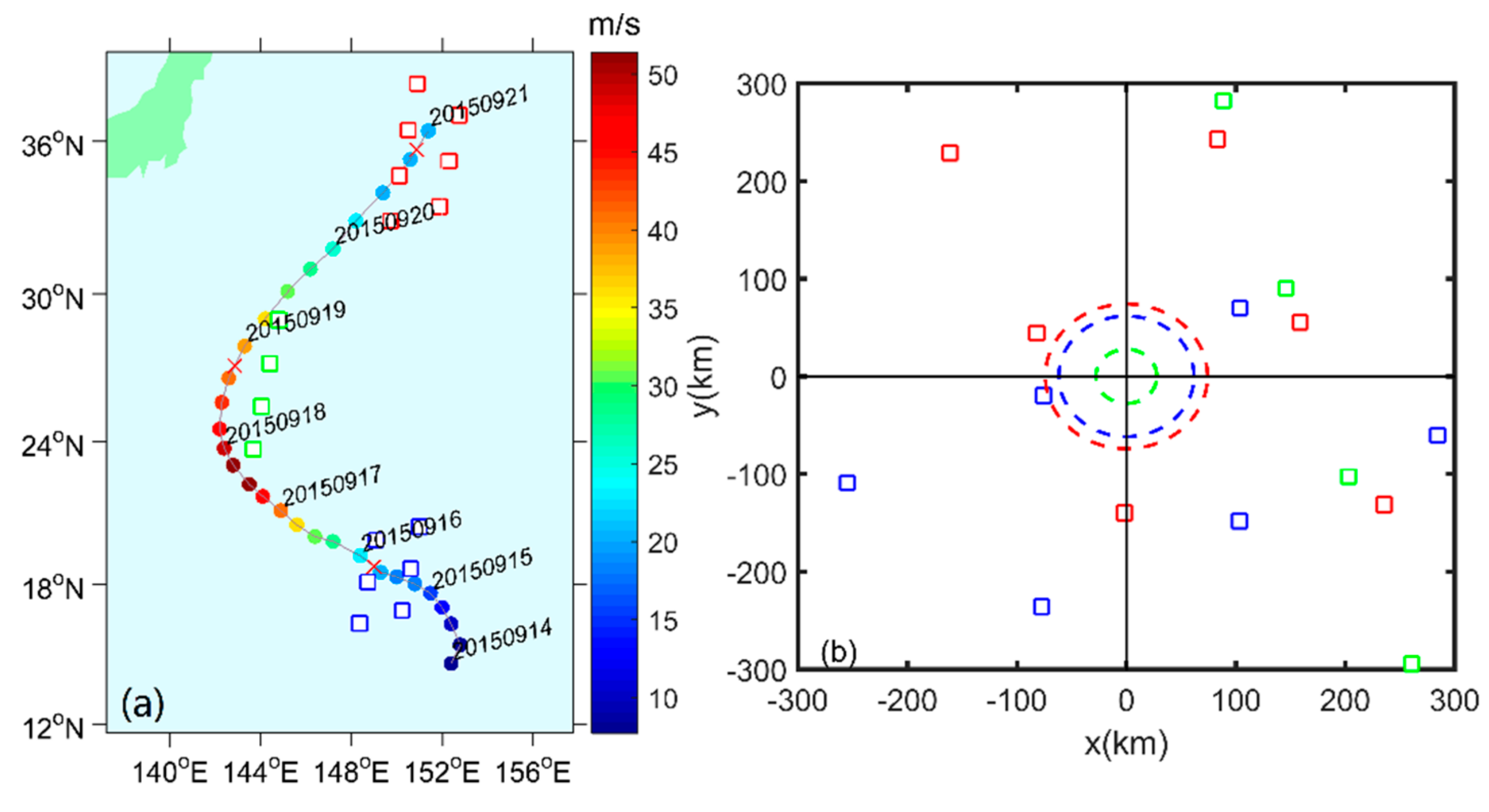


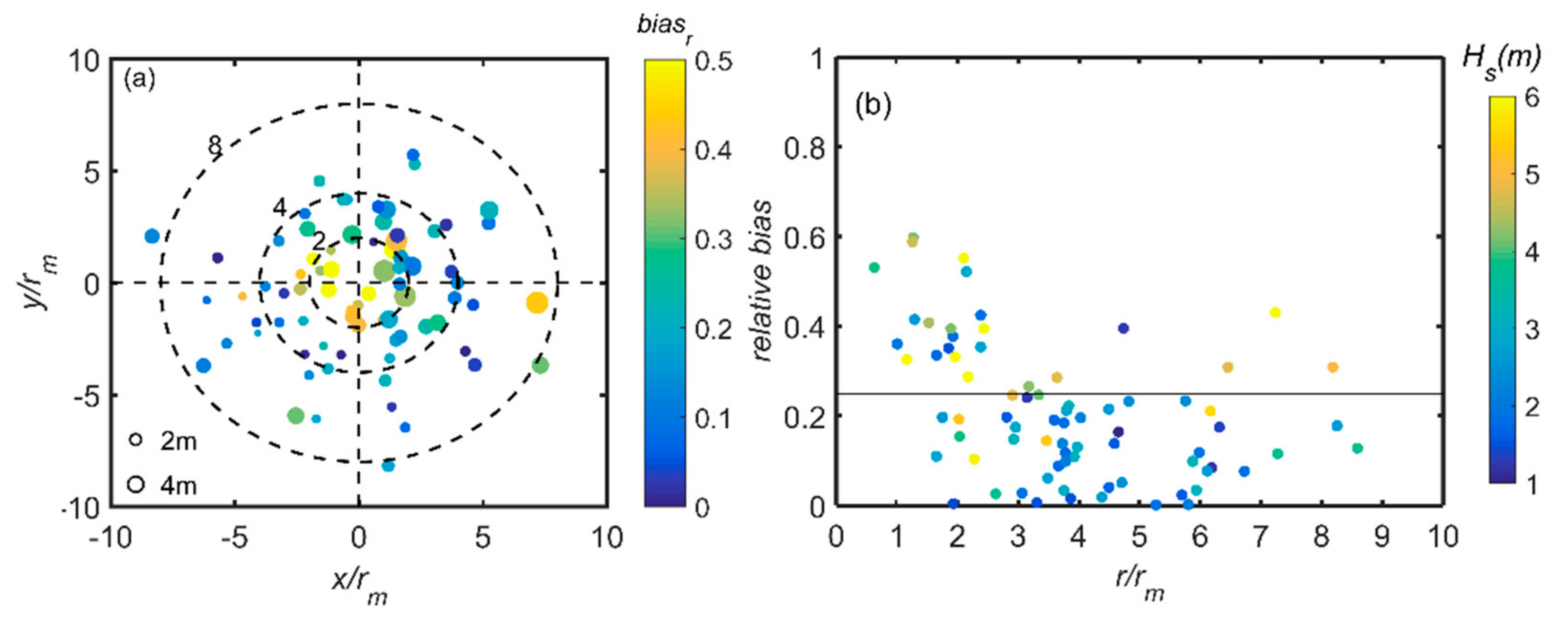

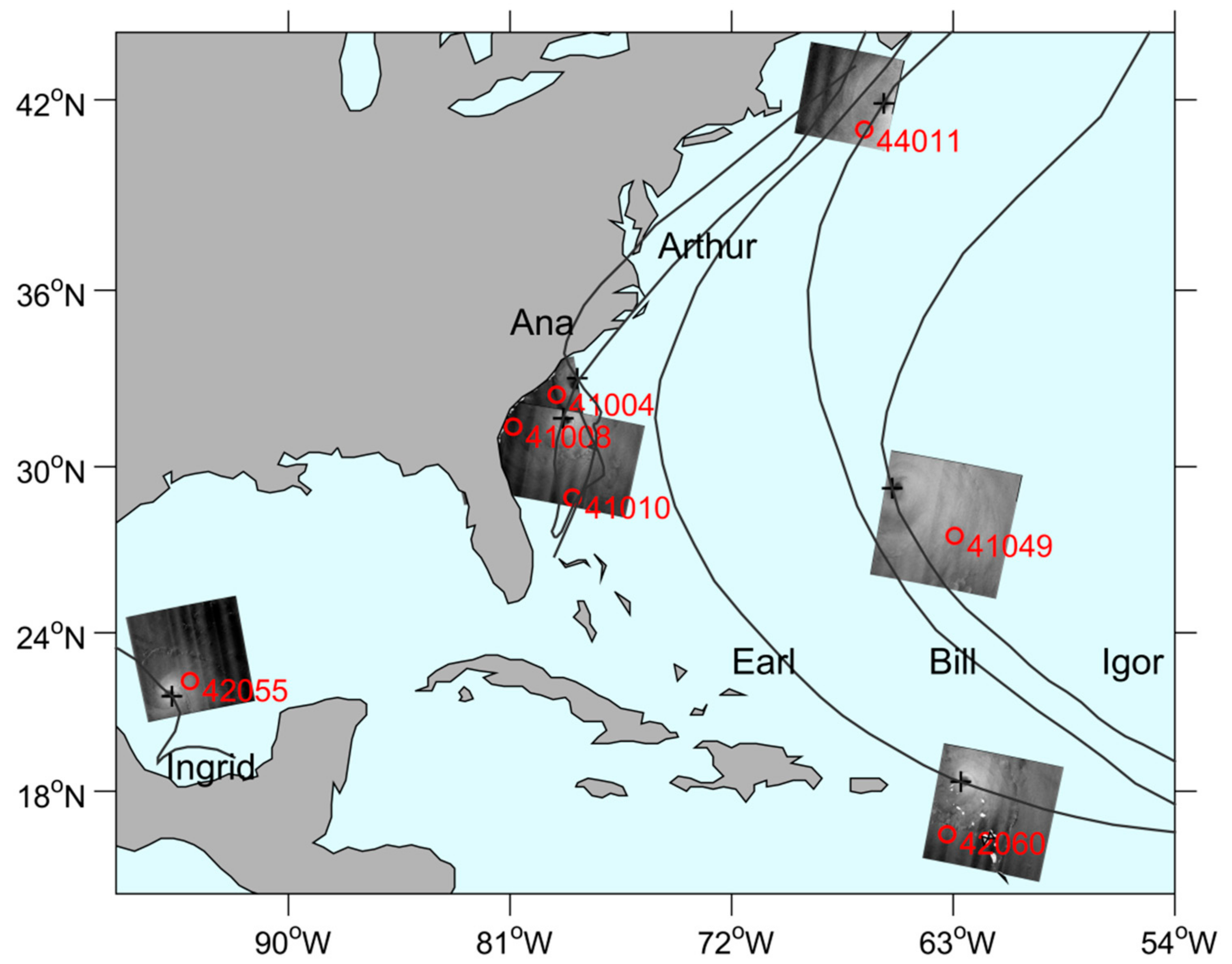
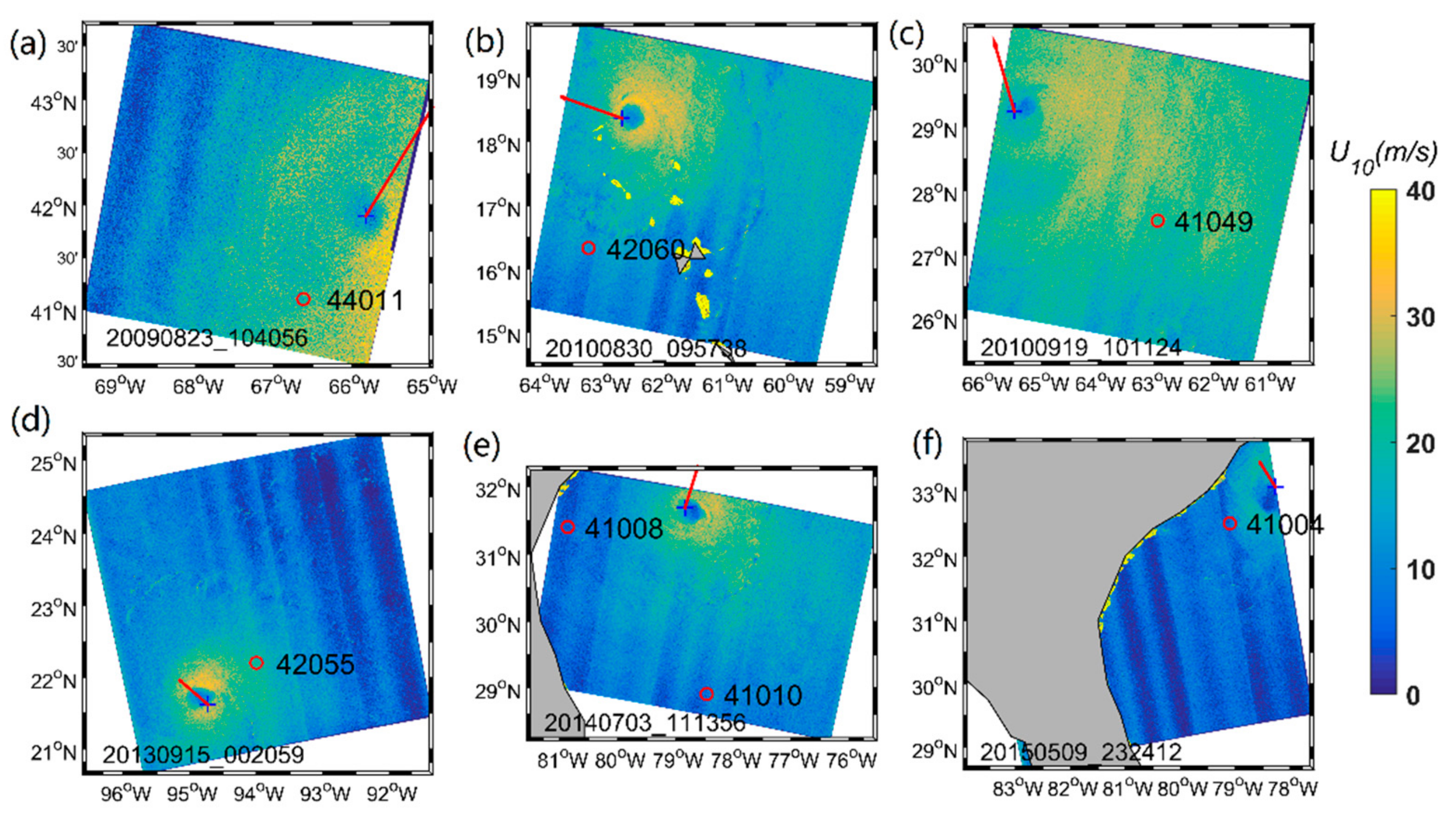
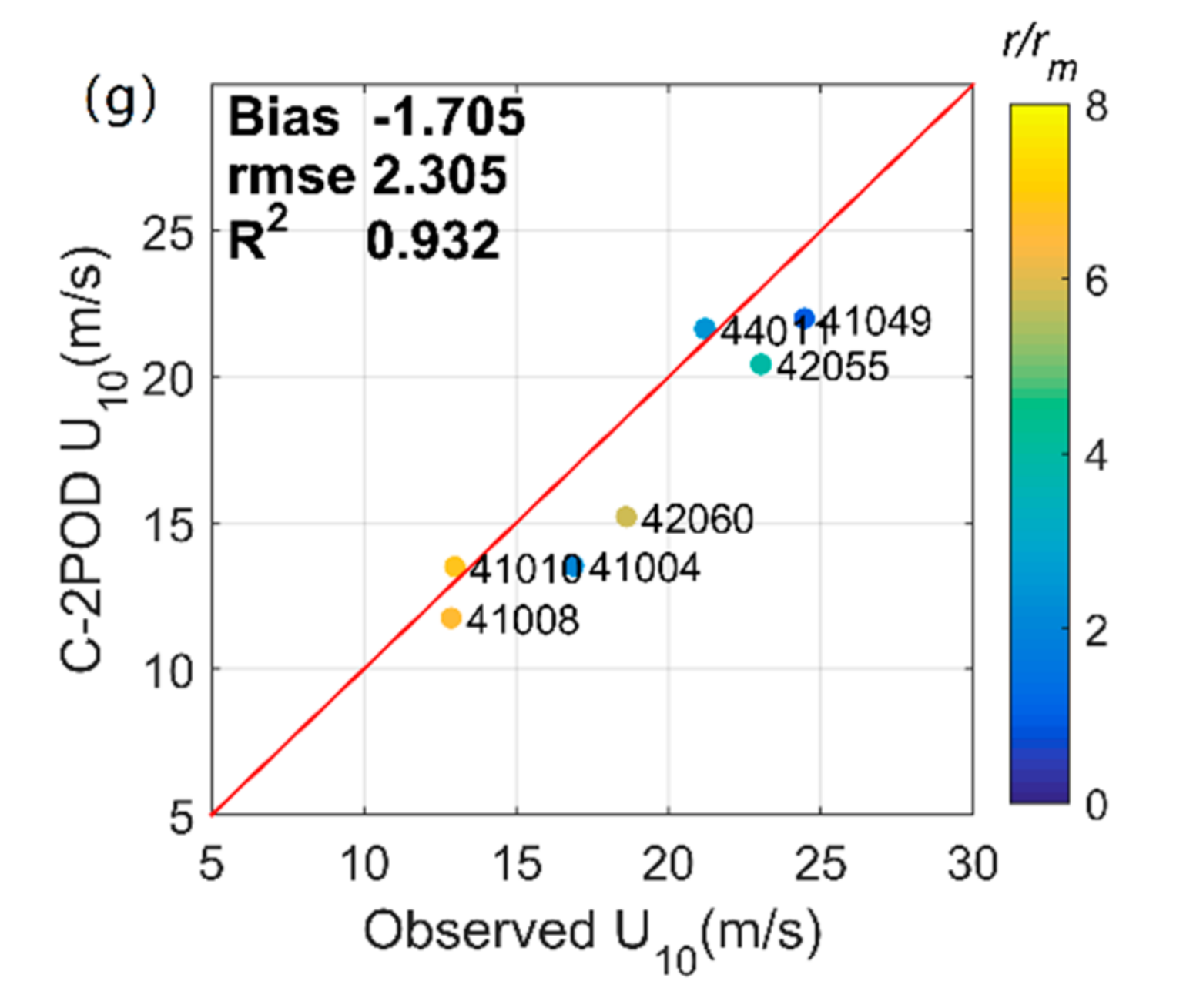




| Hurricane Names | Date (yyyy-mm-dd) | Time (UTC) | Center | um (m/s) | rm (km) | |
|---|---|---|---|---|---|---|
| Latitude | Longitude | |||||
| Bill | 2009-08-23 | 10:40:56 | 41.89°N | −65.82°E | 36.57 | 74.08 |
| Earl | 2010-08-30 | 09:57:38 | 18.36°N | −62.69°E | 52.26 | 49.45 |
| Igor | 2010-09-19 | 10:11:24 | 29.24°N | −65.48°E | 38.58 | 92.60 |
| Ingrid | 2013-09-15 | 00:20:59 | 21.62°N | −94.73°E | 38.58 | 37.04 |
| Arthur | 2014-07-03 | 11:13:56 | 31.68°N | −78.84°E | 40.49 | 39.41 |
| Ana | 2015-05-09 | 23:24:12 | 33.06°N | −78.27°E | 23.15 | 74.08 |
© 2018 by the authors. Licensee MDPI, Basel, Switzerland. This article is an open access article distributed under the terms and conditions of the Creative Commons Attribution (CC BY) license (http://creativecommons.org/licenses/by/4.0/).
Share and Cite
Zhang, L.; Liu, G.; Perrie, W.; He, Y.; Zhang, G. Typhoon/Hurricane-Generated Wind Waves Inferred from SAR Imagery. Remote Sens. 2018, 10, 1605. https://doi.org/10.3390/rs10101605
Zhang L, Liu G, Perrie W, He Y, Zhang G. Typhoon/Hurricane-Generated Wind Waves Inferred from SAR Imagery. Remote Sensing. 2018; 10(10):1605. https://doi.org/10.3390/rs10101605
Chicago/Turabian StyleZhang, Lei, Guoqiang Liu, William Perrie, Yijun He, and Guosheng Zhang. 2018. "Typhoon/Hurricane-Generated Wind Waves Inferred from SAR Imagery" Remote Sensing 10, no. 10: 1605. https://doi.org/10.3390/rs10101605




